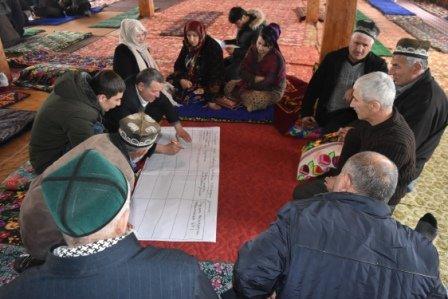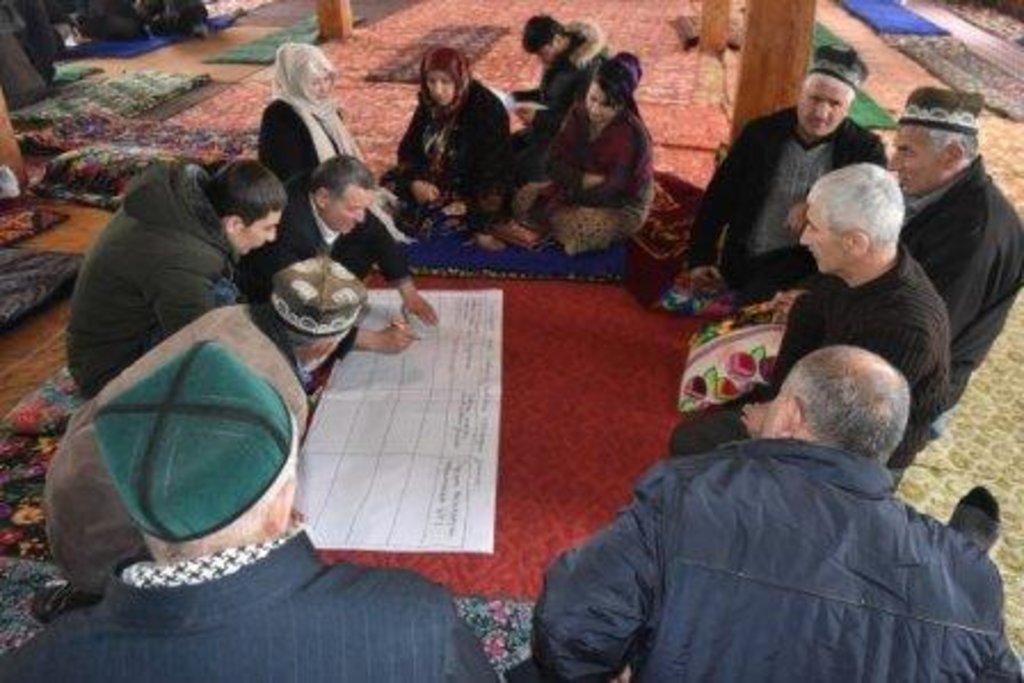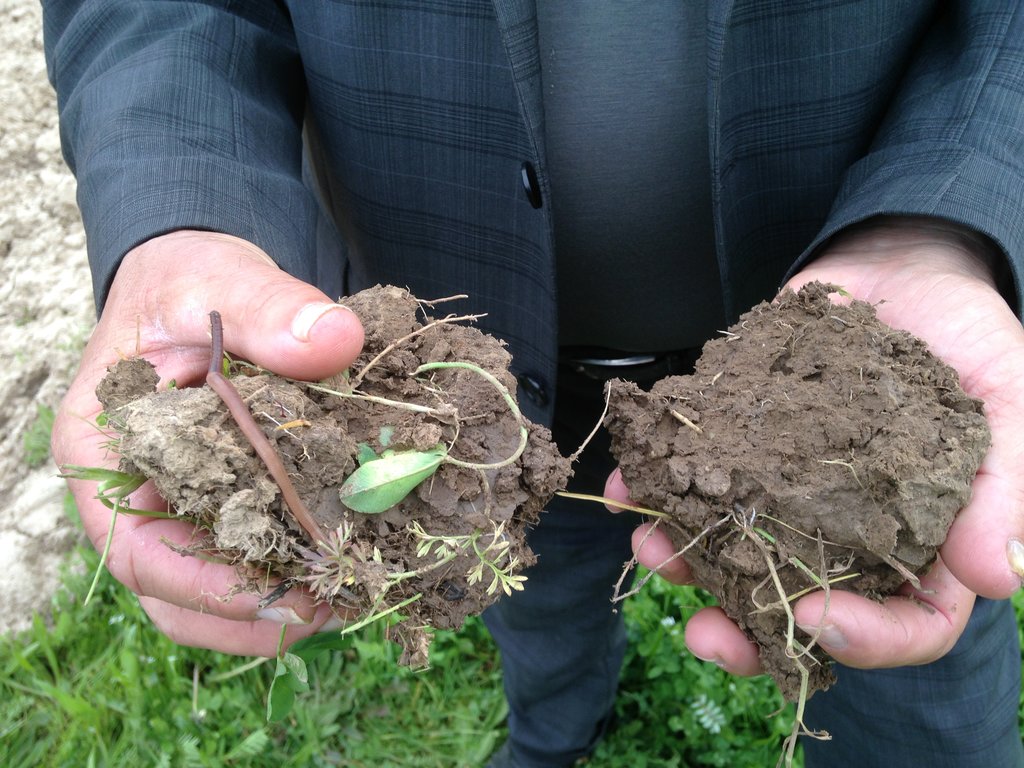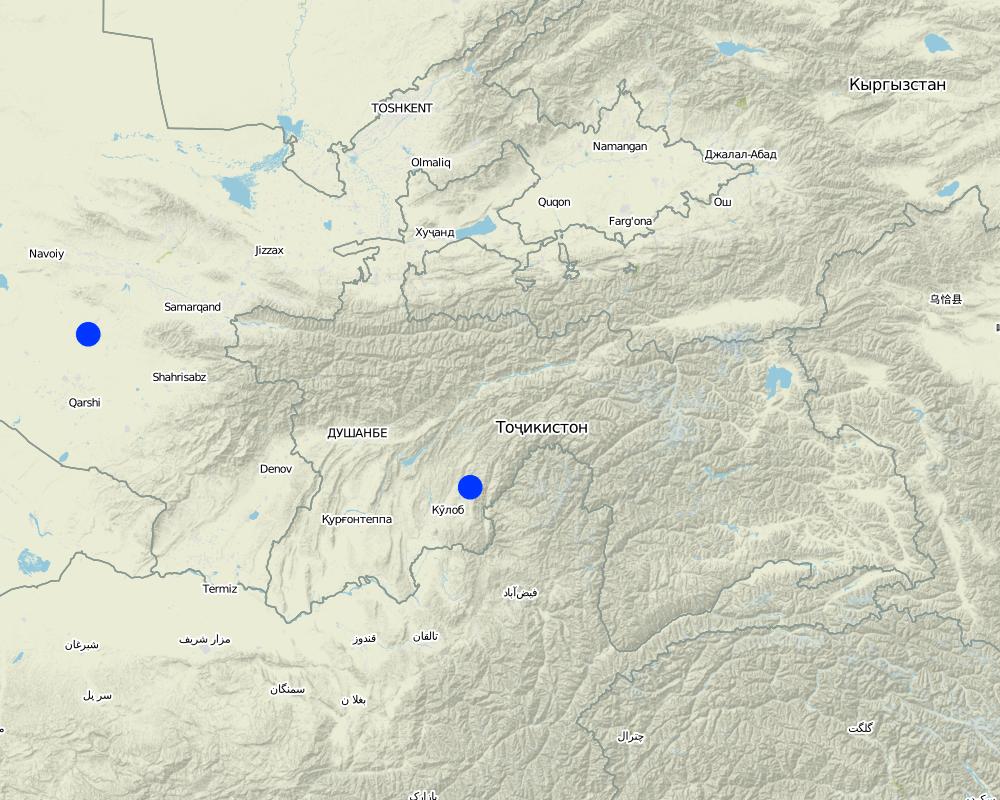Participatory Land use planning and assessment [塔吉克斯坦]
- 创建:
- 更新:
- 编制者: Askarsho Zevarshoev
- 编辑者: –
- 审查者: Farrukh Nazarmavloev
Накшаи муштараки истифодабари ва бахогузории замин
approaches_3635 - 塔吉克斯坦
查看章节
全部展开 全部收起1. 一般信息
1.2 参与方法评估和文件编制的资源人员和机构的联系方式
有助于对方法进行记录/评估的项目名称(如相关)
Integrated Health and Habitat Improvement in Rasht Valley, Tajikistan有助于对方法进行记录/评估的机构名称(如相关)
Aga Khan Foundation (AKF) - 瑞士1.3 关于使用通过WOCAT记录的数据的条件
(现场)数据是什么时候汇编的?:
25/07/2017
编制者和关键资源人员接受有关使用通过WOCAT记录数据的条件。:
是
1.4 SLM技术问卷的参考
2. SLM方法的描述
2.1 该方法的简要说明
Participatory Land Use Planning and Assessment is an inter disciplinary approach to the land use with combination of the modern tools and community knowledge to identify land degradations with its intensity and trends and through this approach design intervention directed toward land degradation prevention. This approach also compiles different tools including PRA and soil assessment and LADA techniques in a participatory manner. The approach address issues with all categories of land use including crop and pasture land, forest and even settlement with regards to natural disaster consideration for construction.
2.2 该方法的详细说明
该方法的详细说明:
As a precondition to the development of evidence- and needs-based plans, Participatory Land Use Planning and Assessment (PLUPA) will be conducted, with participation of local specialists, to assess sub-watershed natural and human-induced hazards and natural resource conditions, and IHA results will be presented to community and local government stakeholders to foster ownership. The outcome will improve community involvement in development by enhancing the ability to conduct local development planning and implementation.
Attention will be given to promoting the role of women in local development.
The PLUPA will employ terrestrial inspection of the land using simplified tools based on the WOCAT questionnaire for the land management technologies. The field-based assessment will include physical inspection of the land use and collecting necessary data like GPS points and information on target watershed (e.g. availability of pastureland, natural hazards, public and private infrastructure). The remote sensing component will be used for analyzing images and identification of trend analysis as well erosion on soil, land degradation.
Communities (via CSOs) and local governments are involved in conducting PLUPA, and will drive and own the result for development of their plan at watershed level. They will also be core stakeholders in the prioritization of water, health, and NRM interventions as per watershed management plan, and will be partners and contributors (including financially) in construction and management of new infrastructure post-project. This fosters commitment and ownership, promoting development that is accountable, participatory, inclusive, transparent, and efficient.
2.3 该方法的照片
2.5 采用该方法的国家/地区/地点
国家:
塔吉克斯坦
Map
×2.6 该方法的开始和终止日期
若不知道准确的年份,请注明该方法的大致开始日期。:
不到10年前(最近)
2.7 方法的类型
- 基于项目/方案
2.8 该方法的主要目的/目标
The main goal of the approach is to bring together stakeholders to use simplified methods on soil assessment and raise awareness on the importance of soil health for production. Based on that approach communities will design action for better management of their land and soil conservaiton
2.9 推动或妨碍实施本办法所适用的技术的条件
社会/文化/宗教规范和价值观
- 阻碍
people are not organized well and land use planning is taking place on a add-hoc basis. traditional knowledge, which is bind to local culture and social norms is lost with applying pre-modern agriculture practice for what community does not have proper access to resources, such as inputs and tehcnology
机构设置
- 启动
法律框架(土地使用权、土地和水使用权)
- 启动
farmers are organized in a legal structure, which is make them compliant to the land rights and supported with planning for land use
了解SLM,获得技术支持
- 阻碍
not all farmers, which got land have farming knowledge and practices on SLM. Basic practices which they learn from other farmer or inherited from their generation.
市场(购买投入,销售产品)和价格
- 启动
there is a lot of demand for food products in the markets and existing service providers who supply inputs. If land use planning is organized in a good way community will get good benefit from farming.
3. 相关利益相关者的参与和角色
3.1 该方法涉及的利益相关者及其职责
- 当地土地使用者/当地社区
land users, forest user, pasture users,
plan and provide field based knowledge on land use practices
- 社区组织
village organization and different initiative groups with regards to land use
support with mobilizing communities for better planning of the land resource and motivate collaboration between different land users
- SLM专家/农业顾问
land management, forest, pasture specialist from related department of government
support with providing technical knowledge and solving the current land use issues with applying/providing good practices
- 地方政府
sub-district and district level
facilitate the process of collaboration among different land users and make decision on future perspective of land use
3.2 当地土地使用者/当地社区参与该方法的不同阶段
| 当地土地使用者/当地社区的参与 | 指定参与人员并描述活动 | |
|---|---|---|
| 启动/动机 | 外部支持 | land users of different categories, including pasture users, forest user etc,. come together to discuss the future land use perspective and decide on organizing themselves in better management of their land resources |
| 计划 | 互动 | all stakeholders involved and support different perspective of land use categories and jointly plan for the future land use |
| 实施 | 外部支持 | all stakeholders, involved in different land use categories negotiate and agree on terms and condition with regards complement the different land use importance. |
| 监测/评估 | 被动 | all stakeholders are passive in following the progress and results from land use intervention. |
3.4 有关SLM技术选择的决策
具体说明谁有权决定选择要实施的技术:
- 主要是SLM专家,咨询土地使用者之后
解释:
the approach is introduced in the framework of the projects and only SLM specialists consult on the tools and approach how to plan
明确做出决策的依据:
- 对充分记录的SLM知识进行评估(基于证据的决策)
4. 技术支持、能力建设和知识管理
4.1 能力建设/培训
是否为土地使用者/其他利益相关者提供培训?:
是
明确受训人员:
- 土地使用者
- 现场工作人员/顾问
如果相关,请说明性别、年龄、地位、种族等。:
training on soil assessment, land management and participatory land use planning and assessment
培训形式:
- 在职
- 公开会议
涵盖的主题:
land degradation, soil assessment, land management
4.2 咨询服务
土地使用者有权使用咨询服务吗?:
否
4.3 机构强化(组织发展)
是否通过这种方法建立或加强了机构?:
- 是,少许
具体说明机构的强化或建立程度:
- 本地
说明机构、角色和职责、成员等。:
land use committee under the village organization as small entity dealing with land issues in the community only
具体说明支持类型:
- 能力建设/培训
提供进一步细节:
land management, land degradation prevention
4.4 监测和评估
监测和评估是该方法的一部分吗?:
否
4.5 研究
研究是该方法的一部分吗?
否
5. 融资和外部物质支持
5.1 该方法中SLM组成部分的年度预算
如果不知道准确的年度预算,请给出一个范围:
- < 2,000
5.2 为土地使用者提供财政/物质支援
土地使用者是否获得实施该技术的财政/物质支持?:
否
5.3 对特定投入的补贴(包括劳动力)
- 无
如果土地使用者的劳动力是一项重要的投入,那么是不是:
- 自愿
5.4 信用
是否根据SLM活动的方法给予信用值?:
否
5.5 其它激励或手段
是否有其他激励措施或工具用于促进SLM技术的实施?:
是
如果是,请具体说明:
some funding was made available for implementation of action prioritized in the land use planning
6. 影响分析和结论性陈述
6.1 方法的影响
该方法是否有助于当地土地使用者,提高利益相关者的参与度?:
- 否
- 是,很少
- 是,中等
- 是,支持力度很大
the process follow by series of capacity building trainings, which are empowering community to get knowledge and understanding
这种方法是否有助于基于证据的决策?:
- 否
- 是,很少
- 是,中等
- 是,支持力度很大
as the approach involve participatory methods decision is made equally by all stockholders, including land users
该方法是否帮助土地使用者实施和维护SLM技术?:
- 否
- 是,很少
- 是,中等
- 是,支持力度很大
as a result of the approach action plan with implementing of technologies is involved
该方法是否调动/改善了使用财务资源实施SLM的途径?:
- 否
- 是,很少
- 是,中等
- 是,支持力度很大
the approach results in a sophisticated document as plan and assessment report, which will then attracts funding for easy reference
该方法是否缓解了冲突?:
- 否
- 是,很少
- 是,中等
- 是,支持力度很大
the plan is mobilize communities and other stakeholder to collaborate and work together and negotiate and resolve emerging conflicts over resource
6.2 土地使用者实施SLM的主要动机
- 增加生产
prevention of and application of technologies contribute to improvement of production
- 减少土地退化
soil conservation techniques will be identified to apply for prevention of land degradation
6.3 方法活动的可持续性
土地使用者能否维持通过该方法实施的措施(无外部支持的情况下)?:
- 不确定
若否或不确定,请具体说明并予以注释:
community are only focused to get maximum economic benefit from land and therefore do not pay enough attention to support ecosystem services or environmental aspect of land conservation
6.4 该方法的长处/优点
| 土地使用者眼中的长处/优势/机会 |
|---|
| participatory |
| simply approach applied by community members themselve |
| 编制者或其他关键资源人员认为的长处/优势/机会 |
|---|
| provides visions, empowers land users to negotiate interventions among them, also raise awareness on the sustainability aspects of land use and provides more aspects on land conservation techniques for land term land use |
6.5 该方法的弱点/缺点以及克服它们的方法
| 土地使用者认为的弱点/缺点/风险 | 如何克服它们? |
|---|---|
| time consuming, required a lot of facilitation | more awareness on communities knowledge about long term land use benefits. strengthen local legal framework to sustain and promote the planing process |
| 编制者或其他关键资源人员认为的弱点/缺点/风险 | 如何克服它们? |
|---|---|
| SLM knowledge and capacity | trainings for the local institutes involved in land use planing and management |
7. 参考和链接
7.1 方法/信息来源
- 实地考察、实地调查
40
- 与SLM专业人员/专家的访谈
3
7.2 参考可用出版物
标题、作者、年份、ISBN:
Participatory Land Use Planning, 2011
可以从哪里获得?成本如何?
Free of charge, from SLM compiler
链接和模块
全部展开 全部收起链接
无链接
模块
无模块





